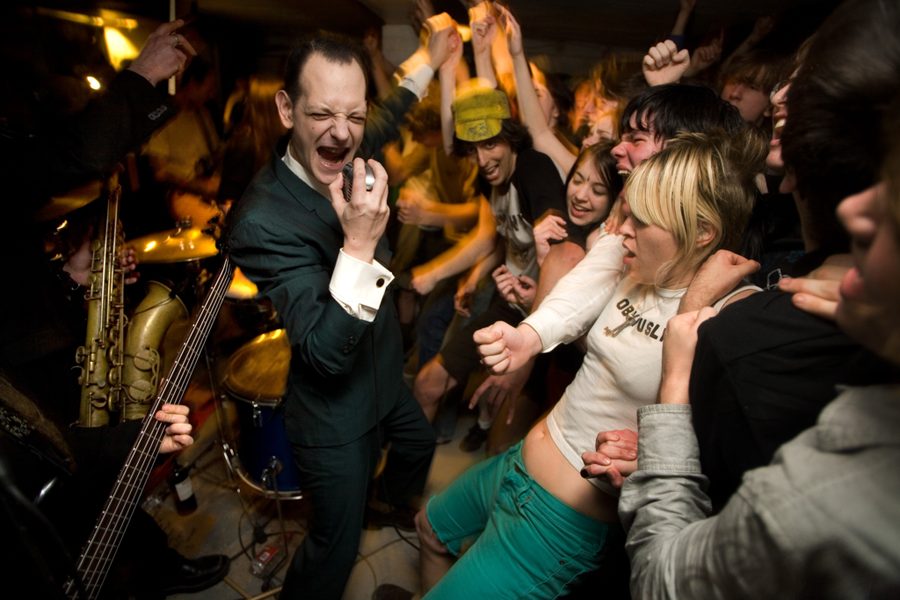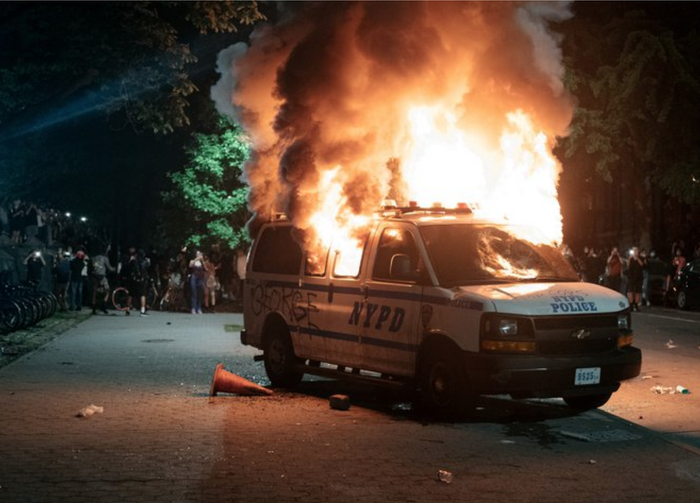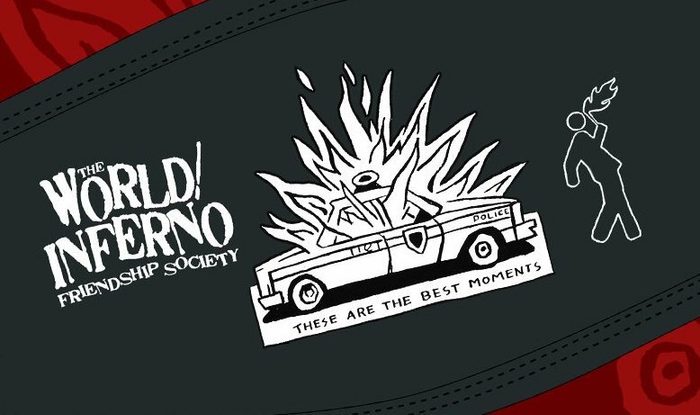RIP Jack Terricloth (1970-2021) of the World/Inferno Friendship Society
Raise a glass to toast the life and legacy of an anti-capitalist, cabaret punk iconoclast.
A.M. Gittlitz

On May 13, Peter Ventantonio, better known as Jack Terricloth, front man of the World/Inferno Friendship Society, passed away at the age of 50. His sister told the New York Times that the cause of death was “hypertensive cardiovascular disease.” Few others in the history of the genre so seamlessly and sincerely combined the poetry, aesthetics, innovation and politics beating in the amphetamine-fueled heart of punk rock.
The World/Inferno Friendship Society was notorious throughout the 2000s, especially among suburban misfits like me, for their drunken, chaotic and other-worldly spectacles. Jack resembled Cabaret’s Master of Ceremonies, welcoming the crowd into a vital urban terrain where youth was permitted to be fast and dangerous. Songs decrying capitalism and romanticizing drugs, booze, petty crime, running from cops and intense short-lived romances are common in punk. What set World/Inferno apart was that they kept their promise.
Like many of his fans to come, Ventantonio hailed from a dull middle-class sprawl, in the town of Bridgewater, New Jersey. In high school he formed Stick and Stones which, like many other Jersey hardcore bands, pushed the confines of the genre towards the small-town poetry of Springsteen but crooned as dark as Glenn Danzig.
In 1997, World/Inferno burst out from these confines with their first release, The Bridgewater Astral League, a punk opera transforming the sleepy suburb into an expressionist set piece populated by a secret society of witchy punks reciting their backwards incantations of political chaos. It was difficult to listen to the album without wondering who these musicians were, how they came up with their bizarre sound, and if their threats against the town’s power structure were in any way serious. The enigmatic debut is perhaps only comparable to another by their regional predecessors: the Misfits’ premier EP Cough/Cool. Once again, the violent fantasies and inside jokes of bored suburban youth had organized themselves in garages and basements into that new type of cadre mobilized against elite society: the punk band.
Around the release of their second album East Coast Super Sound Punk of Today! in 2000, this early, lean version of the band began playing regular shows in New York’s East Village at the collective ABC No Rio and Brownies, on eclectic bills mixing bands like Choking Victim (crust punk), Saetia (screamo) and My Favorite (indie). Also like the Misfits, World/Inferno diligently subscribed new fans to a mailing list, regularly sending them personalized postcards announcing upcoming shows.
It wasn’t long before one of the cultiest of cult-followings developed. Composed of theater nerds, art-school degenerates, goths, riot grrls, aging hardcore toughs, anarchists, circus punks and swing dancers, their fans preferred cheap red wine to malt liquor, speed to weed, suits and fedoras to studs. Were these so-called “Infernites” the hippiest crowd in the East Village and Williamsburg nightlife? Absolutely not. Jack always loved the following for what it was, often comparing the band’s shows to the circus.
Any show with World/Inferno on the bill became a World/Inferno Show — announced by the perennial opener “Tattoos Fade,” a polemic against spectatorship and mindless fandom:
What you’re sure you’re carving in stone
On your flesh
You’d do better living more and commemorating less
There’s much I don’t want to remember
There’s not a thing I’d wish last forever
Your tattoos are gonna fade!
Unique theatrics taken up by the band included spectacularly dangerous fire-breathing, a full kickline during the song “Only Anarchists Are Pretty,” and a jumpy waltz called “Heart Attack ‘64,” during which Jack encouraged fans to ask a stranger to join them in a slow-dance mosh. For many clueless pubescents, this overture could offer a first chance at physical intimacy, as Jack sang: The dope and the wine and the stage/They gave back to me what I gave.
Over time the band ballooned to nearly a dozen members, including a horn section, second percussionist/vocalist Semra Erçin, bassist Yula Beeri, and virtuoso guitarist Lucky Strano, the only member of the band to eschew formal wear on stage for an A-shirt. In interviews, the band would straight-facedly refer to an ever-expanding satirical backstory adapted from Mikhail Bulgakov’s The Master and Margarita. Some of their tall-tales were widely believed. When a bout of appendicitis sidelined Jack from a 2006 tour with the punk group Leftover Crack, he punched-up the story to say the band’s singer Scott Sturgeon had stabbed him in the appendix during a duel on the roof of punk mecca C-Squat.
While they saw success, World/Inferno never received the recognition many thought the band deserved. Tin-eared snobs saw their horn section and fedora-wearing fans and wrote them off as a ska band, reducing their ethnomusicological sophistication. A typical World/Inferno set combined elements of hardcore, northern soul (a British genre popular with Motown b-side-obsessed mods and skinheads), Klezmer, classical and dissonant composition, opera and musical scores.
World/Inferno’s third LP, Just the Best Party (2002), saw the band reach new heights in songwriting and production. Among the tracks that would become classics to fans included, as written on Wikipedia, “a three-song cycle about love and loss in a temporary autonomous zone.”
The album’s opening track “Zen and the Art of Breaking Everything in this Room” hailed a new scene of school-skippers and cheapskates who would sneak into shows (often assisted by the band). The song identified both their friends (punks and fellow travelers) and their enemies: the police, shit-talkers, moralists, and, of course, the yuppies taking over downtown Manhattan and Williamsburg: Pirates and bank robbers/ not lawyers or CEOs / stock brokers ain’t no heroes. If a show wasn’t going well, often because the venue had screwed the band over, they would play the song as a signal to fans, like Black Flag’s cover of “Louie Louie,” to rip the place apart.
Unsurprisingly, these antics eventually gave World/Inferno something of a bad reputation. The latter half of the 2000s saw the terminal decline of squats, DIY spaces and lawless dive bars. The band was often banned from many of the more official venues that remained, both in New York and around the country. In 2006, World/Inferno released one of their most popular records, Red-Eyed Soul, which was followed the next year by Addicted to Bad Ideas, a song-cycle on the life of Hungarian-American actor Peter Lorre.
Soon after, the scene seemed to take on a life of its own, with fans who had met at World/Inferno shows forming collective houses and their own bands. Around this time, many fair weather fans (like me) drifted away along with the band’s star members Lucky, Semra, accordionist/keyboardist Franz Nicolay (also of the Hold Steady), and drummer Brian Viglione (also of Dresden Dolls). I wondered if Jack would give up the character, move on to something else, or just become Pete from Bridgewater again. Instead, Jack remained the only constant, always replenishing the band roster with new musicians for new albums and new fans.
When the shows became sparse in between line-ups, Infernites could still always count on the annual October 31 bacchanal called Hallowmas. It was another tradition borrowed from the Misfits — the elevation of Halloween to the most sacred day on any punk’s calendar. Not only did these shows serve as a point of gravity to keep the band active, and reunite the Infernites, but as a pseudo-religious summoning of World/Inferno’s Charles Schulz-inspired deity, The Great Pumpkin. At these Hallowmas performances, Jack tried on another character, a southern evangelist of this messianic, perhaps satanic redeemer, who emerges from the pumpkin patch each Day of the Dead to heal the year’s mosh pit wounds, hangovers and broken hearts.
Even in 2020, in the midst of the Covid-19 pandemic, Hallowmas occurred, although it lacked much of the danger usually involved in the invocation. Jack helped organize a city-wide scavenger hunt leading fans to a socially-distanced roof-top show. It would turn out to be his farewell performance.
The name World/Inferno referred to the bond between the living and the dead. Jack often sang of tragic figures, kindred spirits, whose art and life were inseparable: Gustav Klimt, Peter Lorre, Phillip K. Dick and Leni Riefenstahl. Two particular inspirations were the Black communist singer and activist Paul Robeson, of whom Jack wrote: Joy beats oppression/But oppression will make you pay/Speak up, black out, black listed, full blooded red, and Gun Club singer Jeffrey Lee Pierce — a blues-preacher beatnik punk poet who lived fast and died young: The Devil don’t let you age gracefully/But the angels never even spoke to me.
In “Ich erinnere mich an die Weimarer Republik” Jack fully embodied his persona inspired by Christopher Isherwood’s Berlin Stories to welcome the audience with burlesque humor to his intercenturial seedy nightclub, temporarily liberated from the everyday misery of economic depression and fascist takeover.
Unlike those perpetually unsatisfied cynics and nostalgists, Jack was a true believer that shows, house parties and riots were trans-historical moments of creative and communal catharsis, always struggling to break from the drudgerous repetition of an everyday life maintained by bosses, bouncers and cops. This was a second meaning of the World/Inferno convergence: the explosive meeting of everyday life and the demonic, Dionysian forces of youth, intoxication, violence, lust and love.
It’s some consolation that Jack, who had commanded in his tribute to Robeson to never “make a man fight all alone again,” lived long enough to see this dynamic demonstrated when thousands emerged from the horrific paralysis of the pandemic one year ago to joyfully smash, steal, drink and outmaneuver the police through the same neighborhoods in New York where World/Inferno once raged. An iconic image from the racial justice protests over George Floyd’s murder showed an empty police vehicle parked at Fort Greene Park, being burned by fearless rebels, dancing in the light of its flames.

The image brought to mind one of World/Inferno’s most popular t-shirt images from the 2000s, an illustration of an NYPD car in flames next to the words: These Are The Best Moments.

Rest in power, Jack.
A version of this piece also appears at Hard Crackers.
A.M. Gittlitz is a journalist and social critic based in Brooklyn, New York. He has contributed to The New Inquiry, The New York Times, The Outline, Baffler, Real Life, Salon, and Vice.




